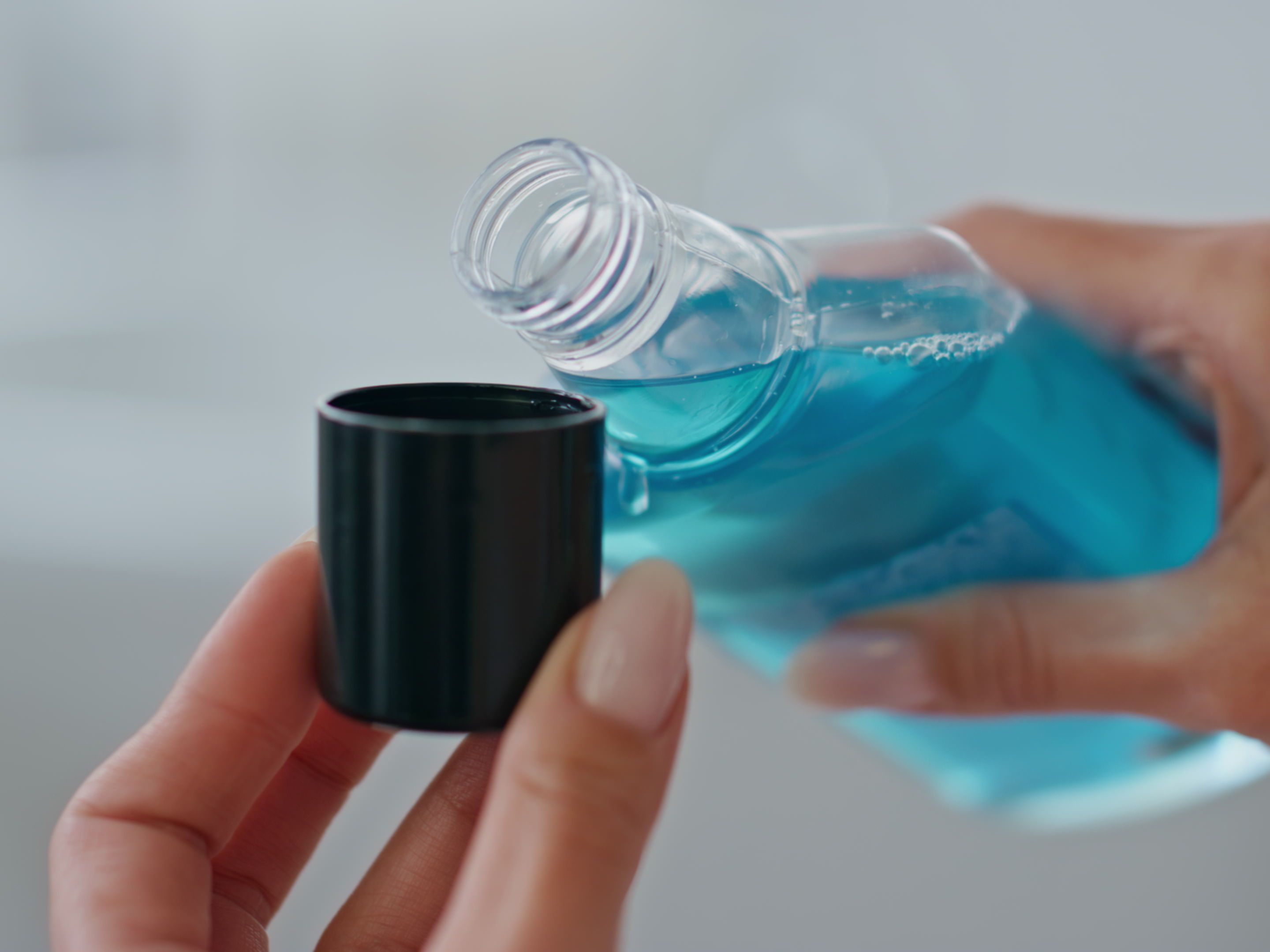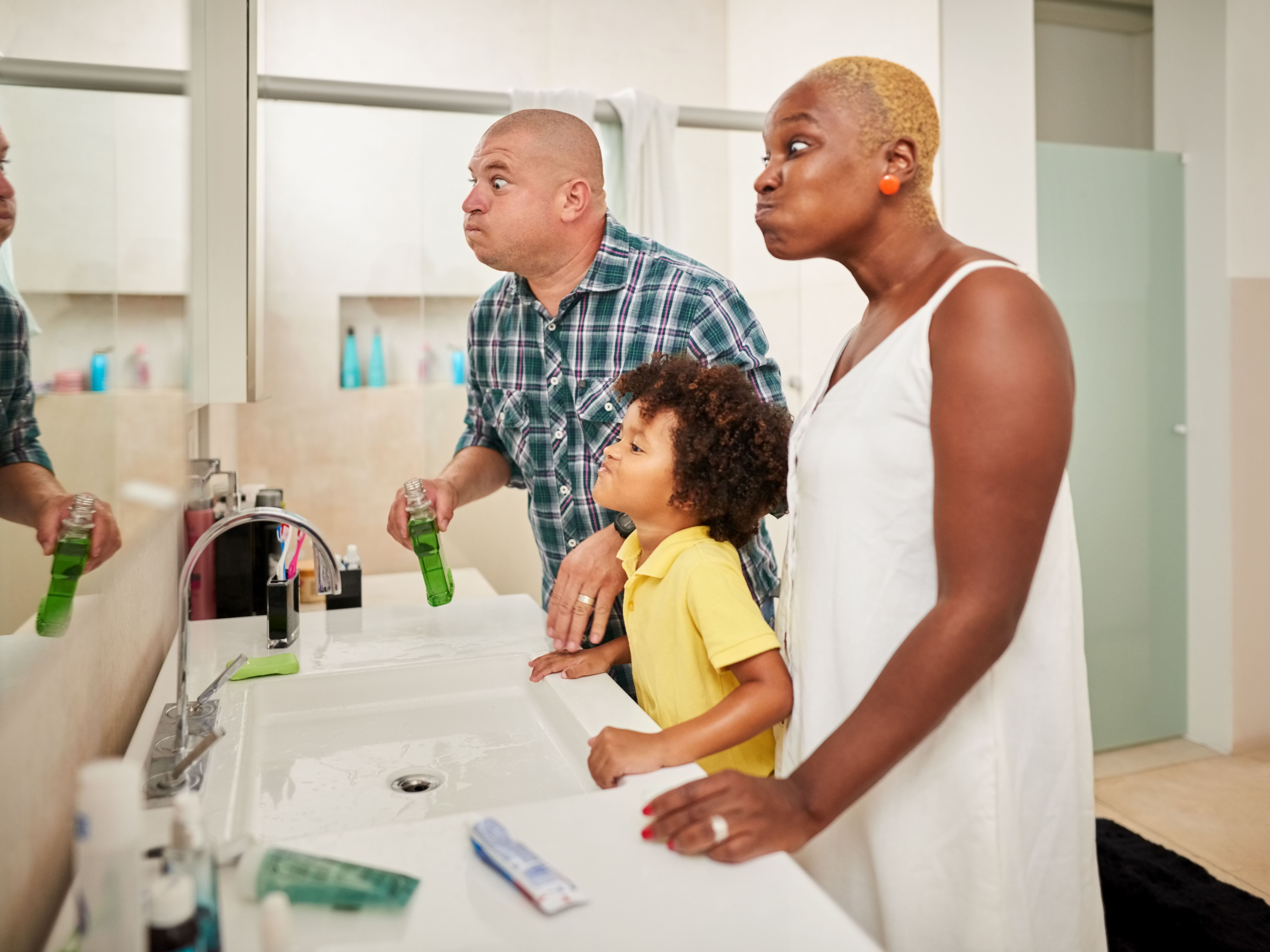Mouthwash: Swish and Spit

The Bottom Line
Mouthwash freshens your breath and helps maintain oral health. Ingredients vary and can include antimicrobial/antiseptic agents, fluoride, alcohol, sweetener, and a flavoring agent. Although you are meant to swish and spit mouthwash, swallowing a mouthful is not harmful. If you swallow a large amount, you may experience toxicity from alcohol and/or fluoride.

What is mouthwash and what does mouthwash do?
Mouthwash and mouth rinse are liquid products with both antiseptic and disinfectant properties. Typically, these products contain a mixture of water and glycerin with an antimicrobial/antiseptic agent such as essential oil (menthol, thymol, eucalyptol), methyl salicylate, chlorhexidine, or hydrogen peroxide. There is also usually a sweetener, preservative, and flavoring agent (such as a mint flavor).
Some mouthwashes contain fluoride and some contain alcohol. Mouthwash is intended to freshen your breath, as well as maintain oral health by killing harmful bacteria, fighting gum disease, preventing plaque build-up, helping to stop cavities from forming, and treating aphthous ulcers. Some products also whiten your teeth. Mouthwash does not replace daily brushing and flossing. It can reach areas that are difficult for a toothbrush to reach.
Is mouthwash with alcohol bad? Is alcohol-free mouthwash better?
Some mouthwashes contain alcohol. The alcohol content usually ranges from around 5% to 27%. Formulations with alcohol can cause a burning or tingling sensation. It is OK to use an alcohol-based mouthwash if you follow the product instructions and swish and spit.
If you have young children in the house or someone with alcohol use disorder, it may be prudent to use an alcohol-free product. If you decide to use alcohol-based mouthwash with young children in the house, be sure the mouthwash has a child-resistant closure. Recently the Consumer Product Safety Commission recalled an alcohol-based mouthwash for lack of child-resistant packaging.
What happens if you swallow mouthwash? Is mouthwash poisonous?
If you swallow a mouthful of mouthwash, you are unlikely to develop toxicity. However, if you swallow larger quantities, you may experience toxicity from alcohol (ethanol), fluoride, and antimicrobial ingredients. Symptoms of ethanol toxicity include nausea, vomiting, drowsiness, coma, and slow breathing. Acute ingestion of fluoride can result in nausea, vomiting, diarrhea, electrolyte abnormalities in the blood, and kidney and heart problems. With the relatively low concentration of chlorhexidine (0.12%) and methylsalicylate (0.06%) in mouthwashes, irritation of the digestive tract is unlikely.
Can mouthwash get you drunk?
Yes, mouthwash can get you drunk, especially if you drink mouthwash containing around 27% ethanol. This concentration of ethanol is higher than that in beer or wine.
Is mouthwash safe to use during pregnancy?
Mouthwash is safe to use during pregnancy if used as intended. Rinse and spit. Don’t swallow.
What should I do if my child drinks mouthwash?
The American Dental Association recommends that children younger than 6 years of age should not use mouthwash or mouth rinse, since large amounts may be swallowed accidentally.
If your child drinks mouthwash, rinse out the mouth with water. Be sure your child is not coughing or choking. Check if the mouthwash contains alcohol and try to estimate how much your child drank. Be sure to have the exact product name available.
If your child swallows mouthwash, gets mouthwash in the eyes, or if you have a question about using mouthwash safely, help from experts is available through the webPOISONCONTROL online tool or by phone at 1-800-222-1222. Poison Control’s expert guidance is always free, confidential, and available 24 hours a day.
Wendy Klein-Schwartz, Pharm.D., MPH
Clinical Toxicologist
Poison Control Media Information
Did you find this page helpful? If so, we need your support. Poison Control is in constant competition with misinformation online. Links to www.poison.org or our webPOISONCONTROL triage tool from other websites and blogs help internet searchers quickly find accurate information and Poison Control’s contact information in an emergency. If you use the content from this page, please provide attribution via a link back to this page, www.poison.org, or https://triage.webpoisoncontrol.org/#!/exclusions. By doing so, you could save a life. Thank you!
Poisoned?
Call 1-800-222-1222 or
Prevention Tips
- Store mouthwashes up, away, and out of sight of children.
- Follow product instructions regarding frequency of use and correct use (swishing, rinsing, and spitting). Some products are not intended for long-term use.
- Purchase a non-alcohol containing mouthwash if you have young children or adults with alcohol use disorder in the home.
- Buy products with child-resistant closures.
This Really Happened
A 2-year-old toddler climbed up onto the bathroom counter, opened an almost full mouthwash container, and swallowed an unknown quantity. The boy’s parents could smell the mouthwash on his breath. The 8-ounce bottle was empty, but some spilled onto the counter and the child’s clothes. The mother called Poison Control and was advised to wipe out his mouth and give the child some fluids. Since the mouthwash contained 26.9% ethanol and the parents did not know how much he drank, Poison Control recommended a medical evaluation. En route to the emergency department, the boy vomited once, and it smelled like mouthwash. On arrival at the hospital, the boy was a little sleepy, but otherwise looked fine. He was observed until the symptoms resolved and then was sent home.For More Information
References
Osso D, Kanani N. Antiseptic mouth rinses: an update on comparative effectiveness, risks and recommendations. J Dent Hyg 2013;87(1):10-18.
Radzki D, Wilhom-Weglarz M, Prushka K, Kusiak A, Odryniec-Kwasnica I. A fresh look at mouthwashes-What is inside and what is it for? Int J Envirn Res Public Health 2022;19(7); 3926. Doi: 10.3390/ijerph19073926
Shulman JD, Wells LM. Acute fluoride toxicity from ingesting home-use dental products in children, birth to 6 years of age. J Public Health Dent. 1997;57(3):150-158. doi: 10.1111/j.1752-7325.1997.tb02966.x.
Poisoned?
Call 1-800-222-1222 or
Prevention Tips
- Store mouthwashes up, away, and out of sight of children.
- Follow product instructions regarding frequency of use and correct use (swishing, rinsing, and spitting). Some products are not intended for long-term use.
- Purchase a non-alcohol containing mouthwash if you have young children or adults with alcohol use disorder in the home.
- Buy products with child-resistant closures.
